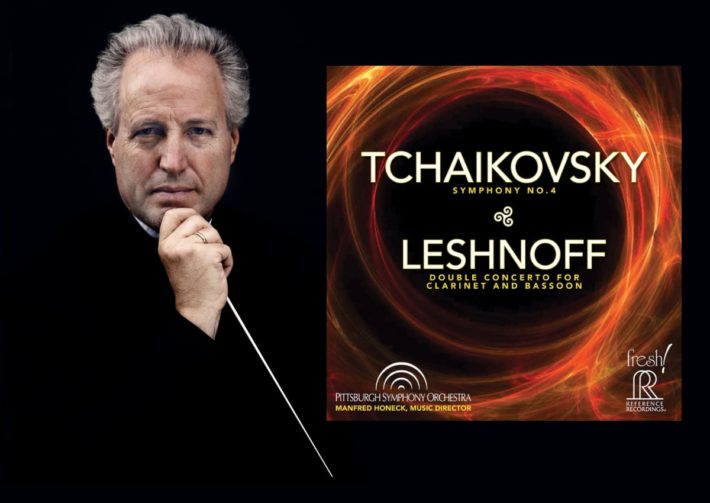Image: © Felix Broede
Honeck and the Pittsburgh Symphony have had a string of successes in recent years, releasing fresh and insightful interpretations of standard repertoire. This new release breaks that pattern, pairing Tchaikovsky’s fourth symphony with a world premiere recording of American composer Jonathan Leshnoff’s Double Concerto for Clarinet and Bassoon.
Tchaikovsky began his fourth symphony at roughly the same time he began his relationship with his patroness Nadezhda von Meck. In one letter he described its composition as follows: “The first movement will give me a great deal of trouble with respect to orchestration. It is very long and complicated: at the same time, I consider it the best movement.” Interestingly, this movement often proves to be the weaker part of many recordings, because of its sprawling structure and the difficulty in choosing a persuasive tempo.
The “fate” fanfare that begins the work shows the Pittsburgh brass on a spine-tingling form. But only 11 seconds in, Honeck introduces the first of several unmarked dynamic “tweaks” (a sudden piano, followed by a crescendo) that, on repeated listening, become distracting mannerisms.
Related Classical Music Reviews
- Review: Tchaikovsky – Violin Concerto – Lozakovich, Spivakov
- Review: Rachmaninov – Paganini Rhapsody, Symphony No. 3 – Abduraimov, Gaffigan
- Review: Tchaikovsky – Complete Works For Solo Piano – Valentina Lisitsa
The main section then begins, “Moderato con anima” (moderate with spirit). Choose too brisk a tempo (as does Gatti with the Royal Philharmonic on Harmonia Mundi) – and the music comes across as hectoring; Gatti skims the surface of the deep despair in Tchaikovsky’s music. At 18’56”, however, Honeck seems too slow. While every note is clearly articulated and beautifully played, with tremendous weight and power at climaxes, something is missing compared to recordings by Nelsons or Petrenko. Both conductors bring out an underlying anxiety and ever-present despair that is only fitfully realized in Pittsburgh. The movement’s climax (Honeck beginning at 7’58”) is undeniably thrilling because of the orchestral sound, but with Nelsons and Petrenko the climax generates a greater emotional catharsis. I was also not convinced by the insertion of a brief comma before spurring the strings to rush headlong into the final 18 bars of the movement, which make is final cadence underpowered.
The inner movements are more convincing. The orchestra’s playing is unassailable, with marvelous characterization from the woodwinds, powerful stentorian brass, and astonishingly articulate strings. Honeck elicits a wonderful palette of colors from his players, and they follow him every step of the way. The playful third movement is, for the most part, a delight, until the final seconds (beginning 4’50”) where Honeck again inserts unnecessary dynamic editing. Honeck’s previous release of Tchaikovsky’s sixth symphony is profoundly moving, as are Mahler and Bruckner performances with the Pittsburgh Symphony Orchestra on this label and others. But in this instance, his interpretative decisions proved unconvincing, and may even prove bothersome to some listeners.
Leshnoff’s “Double Concerto”
Leshnoff’s “Double Concerto” was commissioned by the orchestra and features two of its principals, bassoonist Nancy Goeres and clarinetist Michael Rusinek. Leshnoff’s stature as a composer has grown considerably in recent years, in part due to the 4 recordings of his music released by Naxos. Each of those recordings shows a composer of considerable compositional gifts.
His writing is largely tonal, and this new 17-minute work reminded me of Richard Strauss’s oboe concerto. Its first movement is gentle and languid, gossamer orchestration evoking a spring morning in the countryside. The following two movements are more playful, with friendly banter between the two soloists and their Pittsburgh colleagues. This is not a concerto built on contention between the soloists and orchestra; instead, it is very much a spirit of collaboration and this atmosphere is a much-needed balm after the stormy journey we take in the symphony. It is impossible to imagine a performance better played or more beautiful than this one.
Reference’s recording offers a wide and deep sound stage with a near-perfect mix of clarity and warmth. The liner notes are exceptional: 15 pages devoted to a discussion of the symphony’s history (often numerous quotes from the correspondence between Tchaikovsky and von Meck), and Honeck’s interpretive decisions, as well as a fascinating interview with Leshnoff. The recording is recommended for the concerto, but for the Symphony my allegiance remains with Nelsons, Petrenko and Karajan (1970s/Berlin Philharmonic/DG).

Tchaikovsky – Symphony No. 4, Op. 36
Leshnoff – Double Concerto For Clarinet And Bassoon
Pittsburgh Symphony Orchestra
Manfred Honeck – Conductor
Reference Recordings. CD FR-738SACD
Recommended Comparisons
Read more classical music reviews or visit The Classic Review Amazon store
Follow Us and Comment:
Get our periodic classical music newsletter with our recent reviews, news and beginners guides.
We respect your privacy.









